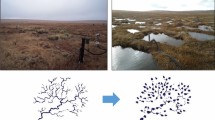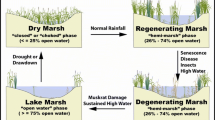Abstract
Land development activities such as agriculture, clear cutting, peat mining, and the planting of forest plantations on wetlands can affect the hydrologic behavior of these ecosystems by affecting their water storage and release patterns on the landscape. The effects of these development activities on hydrologic fluxes in peatlands (Typic Medisaprists) were compared to the effects of forest management practices in North Carolina using a field-tested hydrologic simulation model (DRAINMOD). Simulations revealed that natural peat-based (Histosol) pocosin systems lose 66% (80 cm) of the 123 cm of average annual rainfall by evapo-transpiration (ET) and 34% (42 cm/yr) via annual runoff. Annual runoff values were 63 cm/yr for peat mining areas, 48 cm/yr for cleared peatlands, 46 cm/yr for peatlands converted to agriculture and 34 cm/yr for pine plantations, once the forest canopy is closed. Thus, these wetland alterations, except for forestry, significantly increased runoff and decreased ET compared to the natural ecosystem. Forest pine plantation management decreased runoff and increased ET. A case study of the effects of forest management practices was reviewed for a 15-year-old drained loblolly pine plantation growing on fine sandy loam soils (Thermic Typic umbraquults) in the coastal plains of North Carolina. Forestry activities such as thinning (i.e., reduced leaf area index by 50%) decreased ET and canopy interception and nearly doubled drainage loss (38 cm/yr to 60 cm/yr). Commonly applied forest practices, such as drainage, increased the average number of flow events with flows > 5 mm/day to 86 days per year from 26 days per year under natural conditions.
Similar content being viewed by others
Literature Cited
Amatya, D. M. 1993. Hydrologic modeling of drained forested lands. Ph.D. Dissertation. North Carolina State University, Raleigh, NC, USA.
Badr, A. W. 1978. The physical properties of some North Carolina organic soils and the effect of land development on these properties. M.S. Thesis. North Carolina State University, Raleigh, NC, USA.
Barnes, J. S. 1981. Agricultural adaptability of wet soils of the North Carolina coastal plain. p. 225–237.In C. J. Richardson (ed.) Pocosin Wetlands. Hutchinson Ross Publishing Company, Stroudsburg, PA, USA.
Boelter, D. H. and E. S Verry. 1977. Peatland and water in the Northern Lake States. USDA-Forest Service North Central Forest Experiment Station. General Technical report No. 31.
Campbell, R. G. and J. H. Hughes. 1981. Forest management systems in North Carolina pocosins. p. 199–213.In C. J. Richardson (ed.) Pocosin Wetlands. Hutchinson Ross Publishing Company, Stroudsburg, PA, USA.
CEIP. 1984. Cumulative Impacts of Peat Mining Final Project Report. J.A. Gale and D. A. Adams (eds.) CEIP Report No. 40. NC Coastal Energy Impact Program, Office of Coastal Management, NC Department of Natural Resources and Community Development, Raleigh, NC, USA.
Daniel, C. C. III. 1981. Hydrology, geology and soils of pocosins: a comparison of natural and altered systems. p. 69–108.In C.J. Richardson (ed.) Pocosin Wetlands. Hutchinson Ross Publishing Company, Stroudsburg, PA, USA.
Dolman, A. J., J. B. Stewart, and J. D. Cooper. 1988. Predicting forest transpiration from climatological data. Agricultural Forest Meteorology 42:339–353.
Dunne, T. and L. B. Leopold. 1978. Water in Environmental Planning. W. H. Freeman, New York, NY, USA.
Foutz, T. L. 1983. Effects of peat mining on ground water presses. M.S. Thesis. North Carolina State University, Raleigh, NC, USA.
Gregory, J. D., R. W. Skaggs, R. G. Broadhead, R. H. Culbreath, J. R. Bailey, and T. Foutz. 1984. Hydrologic and water quality impacts of peat mining in North Carolina. UNC Water Resources Research Institute Report No. 214. Raleigh, NC, USA.
Heath, R. C. 1975. Hydrology of the Albemarle-Pamlico-Pamlico Region, North Carolina. A preliminary report on the impact of agricultural developments. US Geological Survey. Water Resource Investigations 9–75.
Hoag, R. E. and E. C. Steinbrenner. 1977. Soil survey of Weyerhaeuser lands in Albemarle District, North Carolina. Weyerhaeuser Company Forest Research Center. Tacoma, WA, USA.
Ingram, R. L. and L. J. Otte. 1982. Peat deposits of Pamlimarle Peninsula Dare, Hyde, Tyrrell, and Washington Counties, North Carolina. U.S. Department of Energy Contract DE-AC18-79FC14693 and NC Energy Institute, Chapel Hill, NC, USA.
Kinerson, R. S., K. O. Higgenbotham, and R. C. Chapman. 1974. The dynamics of foliage distribution within a forest canopy. Journal of Applied Ecology 11:347–353.
Kozlowski, T. T. 1983. Water Deficits and Plant Growth. Vol. III: Additional Woody Plants. Academic Press, New York, NY, USA.
Kramer, P. J. 1983. Water Relations of Plants. Academic Press, New York, NY, USA.
Kramer, P. J. and T. T. Kozlowski. 1960. Physiology of Trees. McGraw-Hill Book Company, New York, NY, USA.
McCarthy, E. J. 1990. Modification, testing and application of a hydrologic model for a drained forest watershed. Ph.D. Dissertation. North Carolina State University. Raleigh, NC, USA.
McCarthy, E. J., J. W. Flewelling, and R. W. Skaggs. 1992. Hydrologic model for drained forest watershed. Journal of Irrigation and Drainage Engineering 118:242–255.
McCarthy, E. J. and R. W. Skaggs. 1992. Simulation and evaluation of water management systems for a pine plantation watershed. Southern Journal of Applied Forestry 16:44–52.
McCarthy, E. J., R. W. Skaggs, and P. Farnum. 1991. Experimental determination of the hydrologic components of a drained forest watershed. Transactions of the American Society of Agricultural Engineers 34:2031–2039.
Mohammad, F. S. 1978. Evaluation of methods for predicting potential evapotranspiration in humid regions. M.S. Thesis. North Carolina State University, Raleigh, NC, USA.
Nelson, P. A. 1986. Variation of saturated hydraulic conductivity with stand age on a forested shallow water table soil. M.S. Thesis. North Carolina State University, Raleigh, NC, USA.
NOAA. 1982. Evaporation atlas for the 48 contiguous United States. Office of Hydrology, National Weather Service, Washington, DC, USA. NOAA Technical Report NWS 33.
Polster, H. 1950. Die Physiologischen Grundlagen der Stofferzeugung im Walde, Bayerischer Landwirtschaftsverlag Gmbh., Munich, Germany.
Ponnamperuma, F. N. 1972. The chemistry of submerged soils. Advances in Agronomy 24:29–96.
Purisinsit, P. 1982. Evaluation of two hydrologic models for the North Carolina blacklands. Ph.D. Dissertation. North Carolina State University, Raleigh, NC, USA.
Richardson, C. J., J. W. Johnson, B. Romano, J. Davis and B. Gilbert. 1987. Water management plan for white tail farm, Hyde and Tyrell counties, North Carolina. Supporting information for NPDES, application no. NC0050288.
Richardson, C. J. and J. W. Gibbons. 1993. Pocosins, Carolina bays, and mountain bogs. p. 257–310.In W. H. Martin, S. G. Boyce, and A. C. Echternacht (eds.) Biodiversity of the Southeastern United States/Lowland Terrestrial Communities. John Wiley & Sons, Inc., New York, NY, USA.
Rutter, A. J., K. A. Kershaw, P. C. Robbins, and A. J. Morton. 1971. A predictive model of rainfall interception in forests. I. Derivation of the model from observations in a plantation of Corsican pine. Agricultural Meteorology 9:367–384.
Skaggs, R. W. 1978. A water management model for shallow water table soils. UNC Water Resources Research Institute Report No. 134. Raleigh, NC, USA.
Skaggs, R. W. 1980. DRAINMOD reference report: Methods for design and evaluation of drainage water management systems for soils with high water tables. Soil Conservation Service. Fort Worth, TX, USA.
Skaggs, R. W., J. W. Gilliam, T. J. Sheets, and J. S. Barnes. 1980. Effects of agricultural land development on drainage waters in North Carolina tidewater regions. UNC Water Resources Research Institute Report No. 159. Raleigh, NC, USA.
Skaggs, R. W., J. W. Gilliam, and R. O. Evans. 1991. A computer simulation study of pocosin hydrology. Wetlands 11: 399–416.
Terry, T. A. and J. H. Hughes. 1978. Drainage of excess waterwhy and how? p. 148–166.In W. E. Balmer (ed.) Proceeding of Soil Moisture-Site Productivity Symposium. USDA Forest Service, State and Private Forestry, Atlanta, GA, USA.
Thornthwaite, C. W. 1948. An approach toward a rational classification of climate. Geological Review 38:55–94.
Thornthwaite, C. W. and J. R. Mather. 1957. Instructions and tables for computing potential evapotranspiration and the water balance. p. 185–311.In Climatology. Drexel Institute of Technology Volume 10, Number 3.
Wiser, E. H. 1975. HISARS-Hydrologic information and retrieval systems reference manual. North Carolina Technical Bulletin No. 215. Raleigh, NC, USA.
Author information
Authors and Affiliations
Rights and permissions
About this article
Cite this article
Richardson, C.J., McCarthy, E.J. Effect of land development and forest management on hydrologic response in southeastern coastal wetlands: A review. Wetlands 14, 56–71 (1994). https://doi.org/10.1007/BF03160622
Received:
Revised:
Accepted:
Issue Date:
DOI: https://doi.org/10.1007/BF03160622




